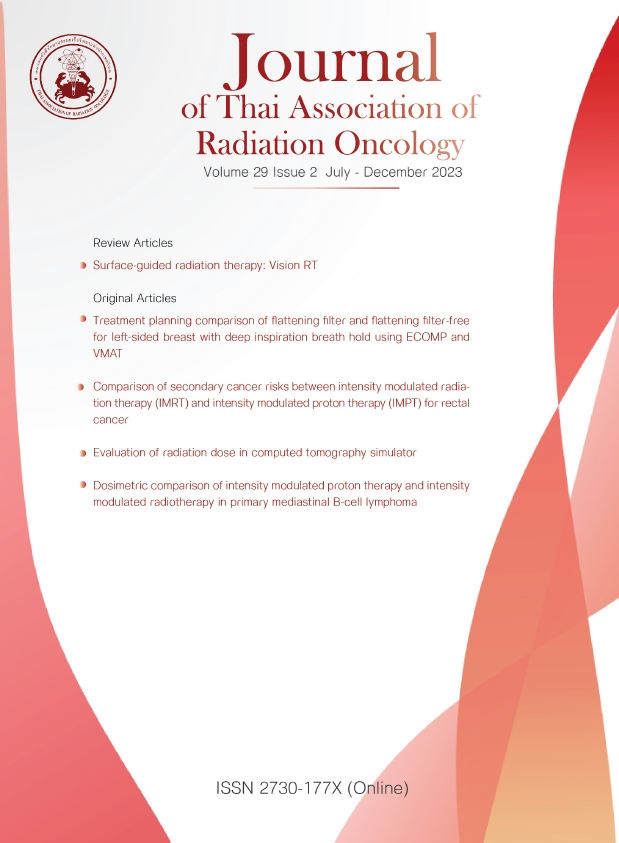Dosimetric comparison of intensity modulated proton therapy and intensity modulated radiotherapy in primary mediastinal B-cell lymphoma
Keywords:
Dosimetric study, Non-Hodgkin’s lymphoma, Proton therapy, IMPTAbstract
Backgrounds
Non-Hodgkin lymphoma is a hematologic disease with excellent outcome after chemotherapy and radiotherapy. However, a patient undergoing radiotherapy is at risk of developing late toxicities such as myocardial infraction, congestive heart failure and radiation pneumonitis which varies according to radiation doses to organs at risk. This study compares the dosimetry of intensity modulated proton therapy (IMPT) with the intensity modulated radiation therapy (IMRT).
Objective
To compare the dosimetry between IMPT and IMRT in patients with primary mediastinal B-cell lymphoma (PMBCL) and measure the difference in target dose coverage, heterogeneity, conformity, and doses to organs at risks.
Material and Methods
Computed tomography (CT) of 12 patients with PMBCL were re-planned with IMRT and IMPT techniques with the prescribed dose of 45 Gy in 25 fractions, which required to covered 95% of PTV in IMRT and 98% of CTV in IMPT. Both plans were compared and evaluated.
Result
Both plans achieved adequate target coverage (98% of CTV for IMPT and 95% of PTV for IMRT). IMPT minimized mean heart, lung, and esophagus doses, with the mean heart and lung dose staying within the QUANTEC threshold. Additionally, IMPT showed better homogeneity but worse conformity when compared to IMRT.
Conclusion
IMPT reduced the radiation doses to organs at risk while achieving adequate target coverage, which might translate to lower acute and late toxicities.
References
Shankland KR, Armitage JO, Hancock BW. Non-Hodgkin lymphoma. Lancet. 2012; 380:848-57.
Ward E, DeSantis C, Robbins A. Childhood and adolescent cancer statistics, 2014. CA Cancer J Clin. 2014; 64:83-103.
Gagliardi G, Constine LS, Moiseenko V. Radiation dose-volume effects in the heart. Int J Radiat Oncol Biol Phys. 2010; 76:77-85.
Ratosa I, Ivanetic Pantar M. Cardiotoxicity of mediastinal radiotherapy. Rep Pract Oncol Radiother. 2019; 24:629-43.
Dunleavy K, Pittaluga S, Maeda LS, et al. Dose-adjusted EPOCH-rituximab therapy in primary mediastinal B-cell lymphoma. N Engl J Med. 2013; 368:1408-16.
Maraldo MV, Brodin NP, Vogelius IR. Risk of developing cardiovascular disease after involved node radiotherapy versus mantle field for Hodgkin lymphoma. Int J Radiat Oncol Biol Phys. 2012; 83:1232-7.
Koh ES, Tran TH, Heydarian M. A comparison of mantle versus involved-field radiotherapy for Hodgkin's lymphoma: reduction in normal tissue dose and second cancer risk. Radiat Oncol. 2007; 2:13.
Dabaja BS, Hoppe BS, Plastaras JP. Proton therapy for adults with mediastinal lymphomas: the International Lymphoma Radiation Oncology Group guidelines. Blood. 2018; 132:1635-46.
Tseng YD, Cutter DJ, Plastaras JP. Evidence-based Review on the Use of Proton Therapy in Lymphoma from the Particle Therapy Cooperative Group (PTCOG) Lymphoma Subcommittee. Int J Radiat Oncol Biol Phys. 2017; 99:825-42.
Illidge T, Specht L, Yahalom J. Modern radiation therapy for nodal non-Hodgkin lymphoma-target definition and dose guidelines from the International Lymphoma Radiation Oncology Group. Int J Radiat Oncol Biol Phys. 2014; 89:49-58.
Pathak P, Vashisht S. A quantitative analysis of intensity-modulated radiation therapy plans and comparison of homogeneity indices for the treatment of gynecological cancers. J Med Phys. 2013; 38:67-73.
Paddick I. A simple scoring ratio to index the conformity of radiosurgical treatment plans. Technical Note. J Neurosurg. 200;93
Ho CK, Flampouri S, Hoppe BS. Proton therapy in the management of lymphoma. Cancer J. 2014; 20:387-92.
Swerdlow AJ, Higgins CD, Smith P. Myocardial infarction mortality risk after treatment for Hodgkin disease: a collaborative British cohort study. J Natl Cancer Inst. 2007; 99:206-14
Hoppe BS, Flampouri S, Su Z. Consolidative involved-node proton therapy for stage IA-IIIB mediastinal Hodgkin lymphoma: preliminary dosimetric outcomes from a phase II study. Int J Radiat Oncol Biol Phys. 2012; 83:260–67.
Li J, Dabaja B, Reed V. Rationale for and preliminary results of proton beam therapy for mediastinal lymphoma. Int J Radiat Oncol Biol Phys. 2011; 81:167–74.
Andolino DL, Hoene T, Xiao L. Dosimetric comparison of involved-field three-dimensional conformal photon radiotherapy and breast-sparing proton therapy for the treatment of Hodgkin’s lymphoma in female pediatric patients. Int J Radiat Oncol Biol Phys. 2011; 81:667–671.
Maraldo MV, Brodin NP, Aznar MC. Estimated risk of cardiovascular disease and secondary cancers with modern highly conformal radiotherapy for early-stage mediastinal Hodgkin lymphoma. Ann Oncol. 2013; 24: 2113–18.
van Nimwegen FA, Schaapveld M, Cutter DJ. Radiation Dose-Response Relationship for Risk of Coronary Heart Disease in Survivors of Hodgkin Lymphoma. J Clin Oncol. 2016; 34:235-43.
Lewis GD, Agrusa JE, Teh BS. Radiation pneumonitis in pediatric Hodgkin lymphoma patients receiving radiation therapy to the chest. Pract Radiat Oncol. 2018; 8:364-368.
Koh ES, Sun A, Tran TH. Clinical dose-volume histogram analysis in predicting radiation pneumonitis in Hodgkin's lymphoma. Int J Radiat Oncol Biol Phys. 2006; 66:223-8.
DeLuca P. Jones D. Gahbauer R, et al. Prescribing, recording, and reporting photon-beam intensity-modulated radiation therapy (IMRT). Journal of the ICRU. 2010; 10:1-106.
Downloads
Published
How to Cite
Issue
Section
License
Copyright (c) 2023 Thai Association of Radiation Oncology

This work is licensed under a Creative Commons Attribution-NonCommercial-NoDerivatives 4.0 International License.
บทความที่ได้รับการตีพิมพ์เป็นลิขสิทธิ์ของวารสารมะเร็งวิวัฒน์ ข้อความที่ปรากฏในบทความแต่ละเรื่องในวารสารวิชาการเล่มนี้เป็นความคิดเห็นส่วนตัวของผู้เขียนแต่ละท่านไม่เกี่ยวข้องกับ และบุคคลากรท่านอื่น ๆ ใน สมาคมฯ แต่อย่างใด ความรับผิดชอบองค์ประกอบทั้งหมดของบทความแต่ละเรื่องเป็นของผู้เขียนแต่ละท่าน หากมีความผิดพลาดใดๆ ผู้เขียนแต่ละท่านจะรับผิดชอบบทความของตนเองแต่ผู้เดียว




